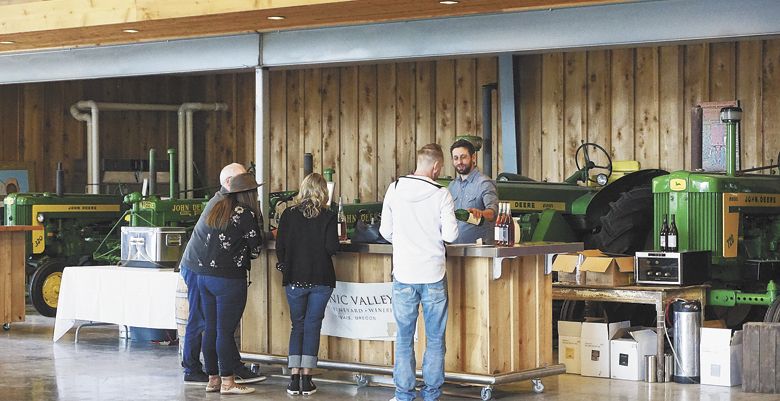Implementing Growth
Scenic Valley adds wine to decades of family farming
While Gabriel Jagle works in the well-equipped wine lab, a turntable spinning Chaka Khan plays in the background. The wines at Scenic Valley Farms in Gervais, reflect the winemaker’s youthful, energetic personality, and yet, there’s ample history here, too, and a solid foundation of agriculture, seven decades to be exact.
Partnering with third-generation farmer Brian Zielinski, Jagle enjoys artistic license in a family with Willamette Valley roots dating to the 1940s. Brian’s grandparents, Robert Zielinski Sr., and his wife, Juanita, once lived a mile from where the tasting room now sits. Their son, Robert (Bob) Zielinkski Jr., Brian’s father, a long-time farmer, increased the family’s acreage methodically over the years. Bob says, “I’ve been doing something for this family since the day I met my wife, [Pam].”
Today, Scenic Valley Farms encompasses approximately 1,200 acres locally; the family owns another 3,000 in Eastern Oregon.
As vineyard manager, Brian oversees their newest crop — he’s also no stranger to filberts, pears, cherries, green beans, corn, wheat, clover, grass seed and more. He first turned a fledgling vineyard of two acres to five, with the Pinot Gris and Grüner Veltliner already planted on the Scenic Valley estate.
“I gotta give credit to my dad about planting a vineyard,” Brian explains. “He and a friend were going back and forth about whether grapes could grow here. He planted them in 2008, and they grew. My dad managed it for a couple years, and I was kind of hands-off. I finally said, ‘Let me do this.’ And he said, ‘If you’re gonna do it, do it.’ That’s the last we heard about that.”
In 2014, Brian bought Hare Vineyard, located in the South Salem hills, taking the total acreage to 30. The diversity within these two vineyards presents a challenge he enjoys. Scenic Valley Vineyard sits at about a 200-foot elevation and contains Missoula Floods sedimentary soils; while Hare Vineyard, topping 800 feet, is planted in red clay Jory soil. A cool-climate site, Hare is planted to Pinot Noir and Pinot Gris — the latter’s distinct expression from the two vineyards is one of many aspects of grapegrowing that fascinates Brian.
Altogether, Scenic Valley grows 90% of its own fruit, with a future goal of 100%. None of the Zielinskis’ grapes are sold. From decades of farming, the family knows they can provide a better cost-effective product to the consumer if they do everything themselves.
As practical as Brian appears, he’s also sentimental about his work. “For me, they are like art,” he explains. “It humbles you to know you can grow a crop. A couple years ago when the California wildfires were raging and 50-year-old vines were going up in flames, I thought. ‘Holy sh**! These are kids, you know? You cut their hair every year, and you know their personalities.’”
Without a skilled craftsman to turn those little bunches into the nectar we so enjoy, grapes can never realize their full potential.
Re-enter Gabriel Jagle.
The winemaker earned his wine stains under the tutelage of Illahe Vineyard’s Brad Ford, among others. Jagle received his technical knowledge via the Northwest Wine Studies program at Chemeketa Community College, which Illahe owner Lowell Ford is credited for initiating. With these two men as strong mentors, Jagle’s appreciation for the tactile aspect of wine seems understandable. “I really like making wine hands-on, making it at my own pace,” Jagle says. “I believe procrastination makes the wine better. I like to stop and think about it instead of rushing in.”
Just like his wife, Miriam, a practicing midwife, embraces the natural approach, Jagle also treats wine with a similar value system. Like his wife, he’s not hard-nosed about it. Ultimately, it is what’s best for the wine.
Most of Scenic Valley’s lineup is unfiltered and wild yeasts are predominantly used. But, he says he refuses to bottle a natural wine that tastes flawed or funky. Instead, Jagle strives to make clean wines with a pleasant palate. A great example of his winemaking philosophy: the 2018 Ramato of Pinot Gris. As he describes it, the wine’s unadulterated and unique, and the stone fruit flavors soften any sharp edges more commonly noted in natural wines.
While Scenic Valley wines are made with terroir in mind, the family takes that concept one step further with Oregon oak. In 2017, French oak was phased out of Scenic Valley’s barrel program, replaced by Oregon white oak exclusively for its 3,500-case production. Appreciating the current effort to preserve local oak savannas in Oregon wine country, Scenic Valley approaches oak sourcing sustainably, partnering with Oregon Barrel Works and reWine Barrels, and using fallen trees from their own property.
A visit to Scenic Valley Farms can feel like a family reunion. The large wine club has a youthful vibe, with lots of young families and children attending scheduled events. Couches encircle a brick fireplace and a children’s play area is located nearby. Small ride-along tractors, an inviting front lawn and sidewalk chalk add to the family-friendly scene. Both Brian and Jagle are dads to young children, and Brian’s sister, Tina, also works in the family business as the CCO, command center operator. Sisters Torene, Tanya and Twynann make appearances, as well.
The presence of old tractors and other farm equipment keep the age range diverse enough, though, and the fact that all this metal is not a well-curated collection but current or past farm “employees” continues to speak to the authenticity of Scenic Valley.
Jagle explains, “A lot of times people are trying to make these rare and unique wines, and we’re trying to make something delicious.”
The majority of the Scenic Valley Farms portfolio is priced at or under $20 a bottle. To learn more, go to scenicvalleyfarms.net. The tasting room, 12423 River Road N.E., Gervais, is open Sundays, noon to 4 p.m., or by appointment.











